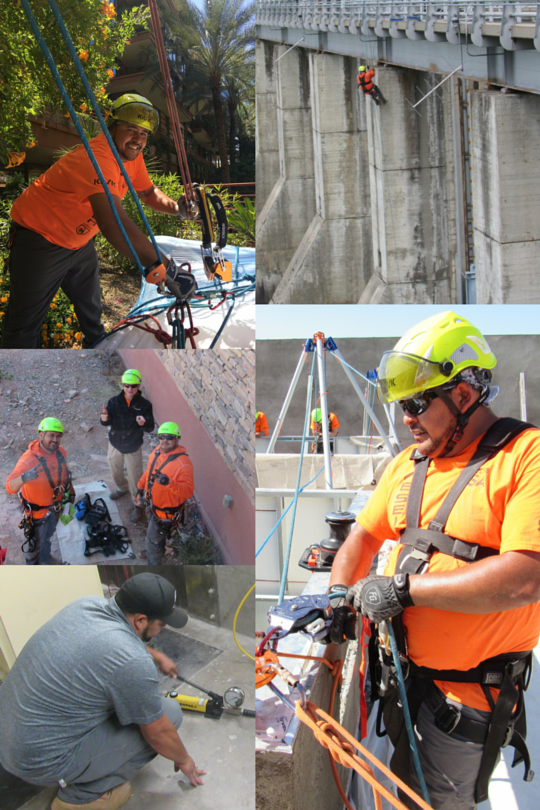When performing rope access, there are few things more frustrating than positioning yourself to perform your work only to realize you forgot something and need to get off line. It’s rare you’ll ever forget anything in your rope access kit, but there are a few things that are necessary and easily forgotten if you aren’t prepared.
- Hydration & Snacks
Hydration seems like an obvious necessity on the job site, but we notice (especially in our desert environment) that it is often underestimated just how much water a person needs to stay hydrated. It’s safe to assume that if you’re performing hard labor or working in heat that you should be consuming at least sixteen ounces of water per hour.
We tend to work ten hour days, and we don’t like breaks. Sometimes that means eating when you can grab a second. We keep protein bars on hand, and bananas to keep up our potassium. It’s important to eat nutritious, clean foods while working on ropes to keep yourself physically well and capable of performing your duties. As a rope access technician, your body is your most valuable and important tool on the job.
- The Unexpected
Performing rope access during the day? Bring head lamps. You brought your ASAP? Bring your Red, too. You already gave a copy of your JHA to the property manager? Bring another. Performing an inspection that requires photos? Bring an extra battery and memory card. Rope grabs. So many rope grabs. Think Boy Scout. Be so prepared that it’s comical, and make it a habit. You can never be too prepared, because the alternative is unacceptable (and unprofessional).
- A Knife
It may seem like a bad idea to have an item that’s sharp while performing rope access, but just like anything else; if you take the right precautions it’s perfectly safe. Keep it tethered, keep it facing away from your body and keep it away from your ropes. I cannot tell you how many times a knife has come in handy when I was performing work at height. There’s nothing more annoying that having to get off line to go track a knife down just so you can complete your work.
- Clothing & Steel toe shoes
You already know the clothing you should be wearing when working at height, and your necessary PPE. This isn’t about that. This is about working within the constraints of your required PPE to be as comfortable and efficient as possible while performing rope access. If my clothes don’t breathe, especially in 120 degree weather, I can’t perform the physical actions required of rope access. The game changer is going to be the first time you wear sweat-wicking/breathable and/or UV protecting clothes. They’ll change your entire outlook on work attire, and you’ll never go back. I got a pair of these pants a few months ago and wore them into the ground, and now I’ve stocked up and they’re all I wear. (Not an exaggeration, I wear them to every job site.)
My other must have, which is still pretty well debated among rope access technicians, is steel toed boots. I’ve spoken to many rope techs who say they don’t feel the need to wear them because they aren’t always performing rope access work on a construction site. Construction or not, they’re incredibly convenient and bring an extra level of safety to your PPE, while giving you the ability to hold yourself in place easily and without injury to your feet. Wearing steel toed shoes while performing rope access work gives me the ability to utilize a unique and effective tool every day with minimal effort.
- Gloves
Sometimes you’ll need different kinds of gloves, but my go-to are baseball gloves. They protect your hands, prevent sweat from interfering with your work, and are thin enough to be able to perform tasks requiring a more delicate touch. Obviously, rigging gloves are great for rigging and more general or hard labor, but thinner gloves give you the ability to keep a strong grip while also maintaining the ability to perform precision tasks.
